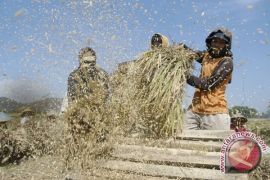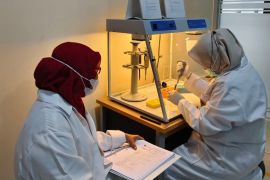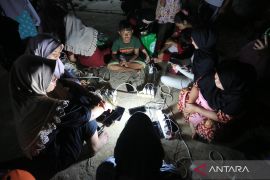At least 2,000 hectares of paddy fields are affected by planthoopers in at least two Central Java districts of Pekalongan and Batang, causing concerns to local farmers over possible failure to harvest their crops.
Head of Pekalongan`s Agriculture, Animal Husbandry and Plantation Service Endang Sulistyaningsih said this week that the life cycle of the pest was difficult to terminate because local farmers planted paddy in uninterrupted seasons.
"Grass virus usually attacks paddy plantations where planthoppers have previously attacked rice plants," she said. Endang said that rice yields in the subdistrict of Kesesi for example are still high, namely reaching about 22,942 tons, yet planthoppers attacks remained a threat to the next paddy plants.
Paddy plants affected by brown planthoppers usually showed syndrome where plants developed skinny posture with short leaves dotted with pale green and brownish colors.
She said that the damage level of paddy plants which were attacked by brown planthoppers was decided by the variety of the paddy concern and its age stage when it was attacked.
"Generally, the older the paddy when it is attacked by pests the smaller the damage it could cause to the plants. The disease syndrome of the affected rice will not be seen until the crops could be harvested," Endang said.
Head of the Agricultural Guidance Section of Pekalangan`s Agriculture and Fisheries Service Bambang Iriyanto said planthoppers` attacks could be avoided by conducting a pattern of planting system, where farmers also panted secondary crops after planting rice.
So far, he said, farmers did not pay attention to the risk aspects such as pest attacks and the effects of other plant diseases. That`s why farmers always conducted uninterrupted paddy panting.
"The anticipatory steps that are good to take for fending off the planthoppers attacks are planting secondary crops after the paddy is planted. The paddy should be planted simultaneously. So far, farmers failed to pay attention to this matter," Bambang said.
In the meantime, in Batang district, brown planthoppers also attacked farmers` crops in a number of villages. It even continued to spread and had now covered three sub districts, namely Bandar, Subah and Pacelungan.
Crops Pest Monitoring Coordinator of Batang Agriculture and Animal Husbandry Service, Susbandoro said here on Saturday that the wide-spread attacks of brown planthoppers and other pests were possible because farmers did not simultaneously plant their crops.
"Planting patterns carried out not simultaneously provide a chance for brown planthoppers to continue their life cycle. It is difficult to stop so that they would attack more paddy fields," he said.
He said that brown planthoppers had attacked 70 hectares of rice fields in Bandar, 22 hectares in Subah and 21 hectares in Pecalungan.
Many farmers are still planting rice in the three sub districts so that the possibility of the pests to continue their life cycle and expand their attacks on crops is very possible.
Susbandoro said that besides brown planthoppers, other borers had also begun attacking a number of villages in Pecalungan.
"The pests have attacked at least 45 hectares of rice fields. The effects of the attack will cause paddy grains to have no content and turn white. If the attacks continue, farmers will face failure to harvest their crops," he said.
He said that in anticipation the adverse effects of the brown planthoppers` and borers` attacks, farmers were called on to also plant secondary crops.
"They can plant secondary crops more easily such as cassava, peanuts and soybeans because these crops do not need much water," Susbandoro said.
He said that if farmers were willing to cut off the life cycle of brown planthoppers and other pests they should conduct crops plantations simultaneously or only plant secondary crops. "We suggest that farmers in the current dry spells plant only secondary crops, rather than paddy," he added.
Even though planthoopers are attacking rice fields in a number of districts in Central Java, the pest attacks are not expected to significantly affect the rice production target in Central Java, a rice production hub along with East Java, West Java and South Sulawesi.
It has the target to contribute 10.43 million tons of rice to the national target of 43.9 million tons.
Sukoharjo district for example, is doing its best to increase rice production in an effort to maintain its reputation as the rice production center in Central Java. "We hope that farmers will increase their rice production," Sukoharjo District Head Wardoyo Wijaya said.
The district head made the appeal to a farmers group "Harguno Merto" which took part in a farmers` national contest held by the Ministry of Agriculture in Sukoharjo recently.
(T.A014/HAJM/O001)
Reporter: by Andi Abdussalam
Editor: Priyambodo RH
Copyright © ANTARA 2011











